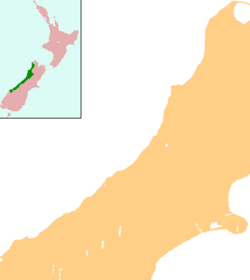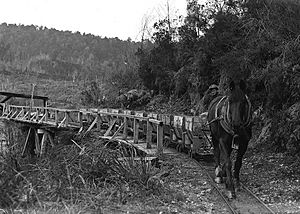Waiuta facts for kids
Quick facts for kids
Waiuta
|
|
|---|---|
| Country | New Zealand |
| Region | West Coast |
| District | Buller District |
| Electorates | West Coast-Tasman Te Tai Tonga |
Waiuta is a historic mining town on the West Coast of the South Island of New Zealand. It is now mostly empty and is known as a ghost town. Waiuta is about 58 kilometers north of Greymouth and 21 kilometers south of Reefton. It was once a busy gold mining town until 1951, when the mine collapsed. This made it too expensive to keep mining there.
Today, some buildings still stand, and a few people still live in Waiuta. It has become a popular place for tourists to visit. You can still see some of the original buildings, like the old police station, three small houses, and the barber shop.
Contents
The Story of Waiuta: A Gold Mining Town
Waiuta was built to provide homes for the people who worked in the gold mine. The main gold vein was called the Birthday Quartz Reef. It got its name because it was discovered on November 9, 1905, which was King Edward VII’s birthday!
The first mine shaft, called the Blackwater Shaft, started working in 1908. It went very deep, about 563 meters underground. In 1926, the mine grew even bigger when it took over a nearby area called the Blackwater North claim. This new part was renamed the "Prohibition" shaft. By 1938, the Prohibition shaft was even deeper, reaching 879 meters.
Over time, the mine produced a huge amount of gold – almost 750,000 ounces (which is about 21.3 metric tons)! As the mine got bigger, more and more workers came to live in Waiuta. At first, people just rented houses because they weren't sure how long the mine would last. But by the early 1920s, the mine was doing very well. Workers then felt confident enough to build their own homes and open shops. Waiuta quickly changed from a simple mining camp into a busy, growing town. Even though it wasn't a huge town, people loved playing outdoor sports, especially rugby.
Waiuta's Busy Years
By 1936, Waiuta was at its busiest, with a record 601 people living there. Many of these residents came from other countries, including Yugoslavia, Italy, and Australia. This made Waiuta one of the most diverse towns in New Zealand at that time.
To help the community, a miners' hall was built in 1910. This was a place for social events and important meetings. Waiuta also got its first school, and by 1933, there were 113 children attending classes. The last major building to be constructed was a small hospital in 1916, which helped care for the town's residents.
Why Waiuta Became a Ghost Town
The Second World War caused the number of miners in Waiuta to slowly decrease. Between 1939 and 1946, the number of men working for the mining company dropped from 240 to just 113. The amount of gold found also became much less, making it hard to find new miners after the war.
Then, on July 9, 1951, a big event happened: the Blackwater Shaft collapsed. The mine quickly filled with water and had to be closed down. Since there were no other jobs in Waiuta, most people had to leave and find work elsewhere. Buildings were taken apart, and within just a few months, Waiuta became a ghost town with almost nothing left.
Waiuta Today: A Historic Place to Visit
Today, Waiuta is looked after as a historic site for tourists. Only a few of the original buildings are still standing. You can even stay overnight at the Waiuta Lodge, which is great for families wanting to explore the area.
Tour guides are part of a group called “Friends of Waiuta,” which started in 1985. They help visitors learn about the town's history, the local plants and animals, and promote Waiuta as a fun place to visit. They work closely with the Department of Conservation, which manages the historic town and old gold mines. The "Friends of Waiuta" group has over 120 members and meets regularly.
The Department of Conservation is also working on restoring the house of Jos Divis. He was a miner and a photographer who took many pictures of life in the mines and Waiuta. His photos help us understand what life was like back then.
In recent years, two documentary films have been made about Waiuta. Whispers of Gold: a tale of boom and bust and a West Coast Town that refused to die was released in 2020. Another film, Jos – The Forgotten Photographer Who Saved a Town, came out in 2023 and tells the story of Jos Divis.
In 2019, the New Zealand government announced a large loan of $15 million to a company called Tasman Mining. This money was meant to help reopen the Blackwater gold mine.
Images for kids




